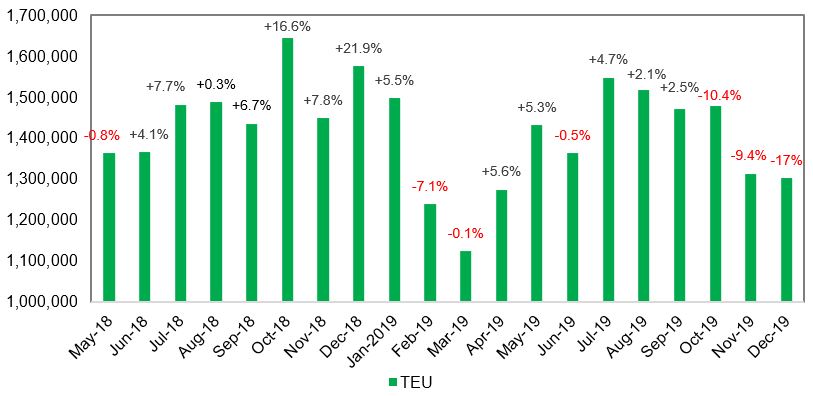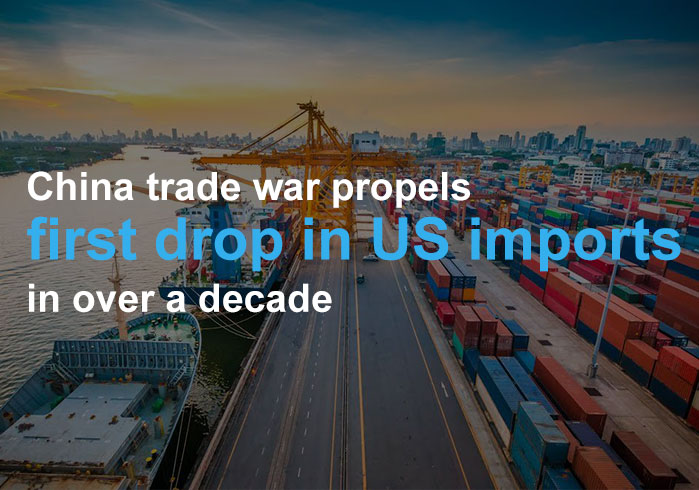For the first time in over ten years, there is a decline in imports to the United States from Asia. This drop is quite substantial, reaching nearly 10%. This change has been felt all over, with West Coast ports being hit the hardest, followed by East Coast ports, and Gulf Coast ports feeling the severity of the trade war to a lesser extent. This annual drop from Asia is more severe in terms of Chinese imports but is still substantial concerning imports from all other Asian countries. Projections do not paint a pretty picture for shippers.
U.S. Imports – Past and Future
Looking back, the past ten years saw regular increases and expansions by carriers continuing to fuel the imports throughout Asia and the United States. Unfortunately, that continued increase appears to be at a standstill as future projections start to paint a picture of decreases. The declines, while not particularly substantial by comparison, still mark a reduction for the first time in over ten years and in so doing indicates that shippers have a lot to look out for when it comes to managing their business over the next few months.
Over the last ten years, it was assumed that a lot of the imports from Asia and China, in particular, would continue uninterruptedly. The last time these import routes were interrupted at all was when China entered the World Trade Organization (WTO) in 2001, the economic recession of 2008, which lasted until 2009. At the time, 2009 saw a decline in imports from Asia of 14.2% with imports from China, specifically dropping 12.4%.
Expert projections on U.S. imports
Projections from experts stipulate that said import rates are expected to continue to decline for February before they turn around even higher in March. Unfortunately, the growth that is projected during springtime will be more likely the result of the Lunar New Year celebrations from Asia, which this year is taking place two weeks earlier than last year and does not represent an increase in demand.
It is expected that import volume will remain stagnant for the first half of 2020, reaching a decrease of 1% by the third quarter. Many experts agree that no return to normalcy will take place until at least the fourth quarter, depending on how the current trade war between China and the United States plays out. Industry professionals hope that a change in political tides will bring about a return to normalcy after the election.
U.S. imports in recent years
Last year U.S. imports from Asia dropped by 2.2%, a total of 16.6 million TEU. The year prior, there was a slight increase of 7.6%, but this import increase pulled back as a result of changing political ties and subsequent economic environments. 2019 saw a great deal of negative change, declining between October and November by 10.4%, November to December by 9.4%, and December to January by 17% compared to the same months from 2018. Manufacturers and retailers shifted a lot of their sourcing to Southeast Asia, increasing exports from other Asian countries by 14.8% in 2019 alone.
Effects of tariffs on ports
Tariffs have impacted ports differently. While all ports have had to contend with the economic changes brought about by the Trade War, different geographic locations have been affected to varying degrees.
West Coast ports hit hardest by tariffs
These trade War-related taxes have had an uneven impact, hitting the West Coast ports hardest. West Coast ports have seen a decline in imports from all over Asia of 5.5% in the last year alone, with imports from China going through West Coast ports dropping 12%. To counter this, there has been a shift of sourcing from China to the Indian subcontinent, with water sources from Asia to the east coast becoming significantly more competitive. Imports through the East Coast from all over Asia have increased by 2.6% in 2019, which stands in direct contrast to the fact that imports from China by way of East Coast ports have dropped 6.8%. Overall imports from Asia, except for China through East Coast ports, have increased a total of 22.9%. Right now, imports from all over Asia, except for China by way of West Coast ports has increased by 9.2%.

Source: IHS Markit
Gulf Coast ports least affected by tariffs
While the West Coast ports were hit the hardest, the Gulf Coast ports are currently the least affected. Imports through Gulf Coast ports from Asian countries have increased sharply over the last three years, especially as carriers are adding services in direct response to the increased volume throughout the region. In 2019 imports from all over Asia increased by 14.3%. Imports from all Asian countries, except for China, jumped from 44.5% between 2018 and 2019, while imports from China specifically increased by 2.3%. All of these increases were the result of capacity carriers being added to the trade lane.
Wrapping up
Overall, the last ten years have provided a great deal of improvement, and carriers of added services in direct response to the volume increases over the previous few years. With the trade war between China and the United States continuing, it seems that the decade of improvement is finally coming to an end. Projections stipulate that for the next six months, at a minimum, shippers will have to contend with declines in imports, reduced volume of traffic, and tariffs. Industry participants hope that at the end of the year, changes to the political climate will bring with it more level-headed decisions that will put an end to the first annual drop in U.S. imports from Asia in over a decade.




